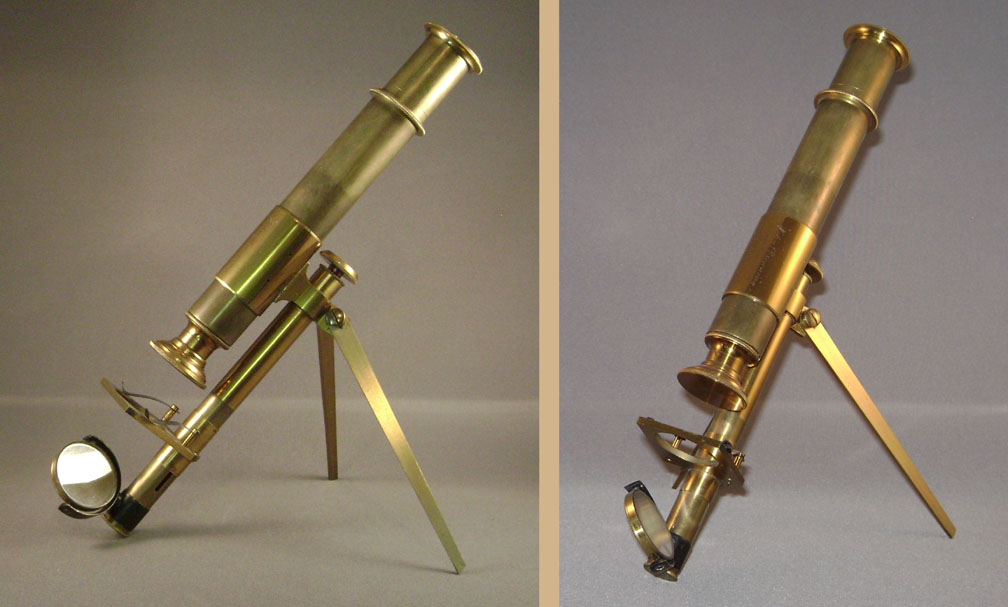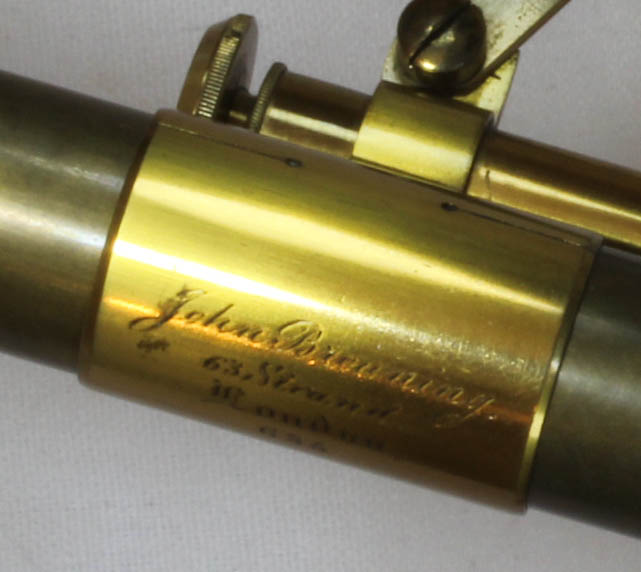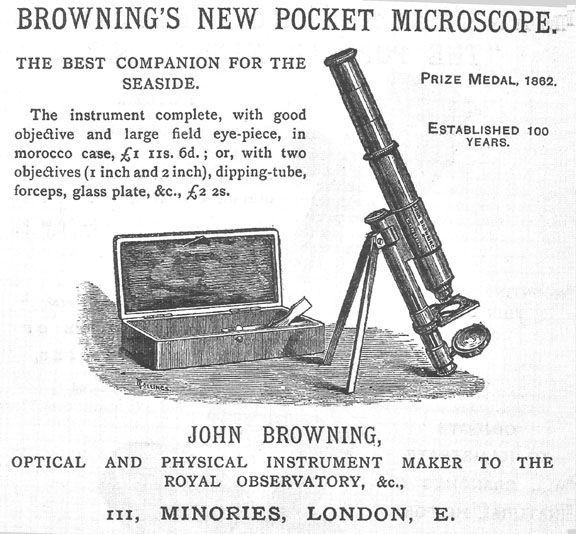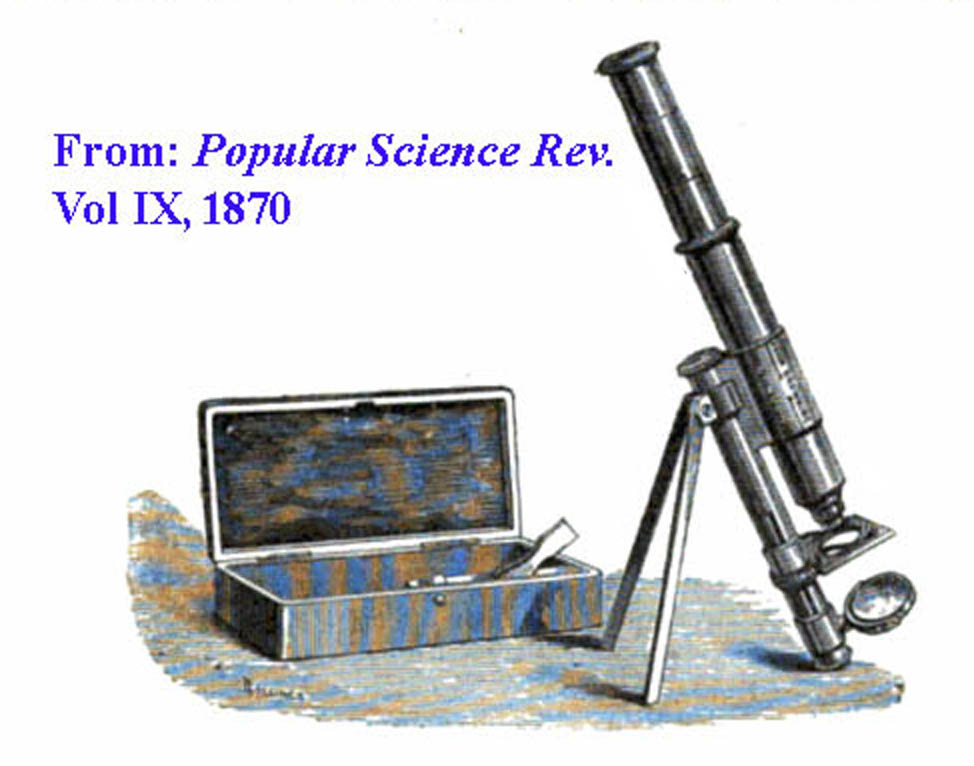MICROSCOPE-ANTIQUES.COM © 2013-20.
'NEW POCKET MICROSCOPE':
c. 1887
SIGNED: JOHN BROWNING,63 STRAND,LONDON
SERIAL NUMBER: 635

DESCRIPTION
 This fine microscope is supported on a folding tripod design with one leg serving as the limb.
Coarse focus is by sliding the optical tube, and there is a fine focus through the foot, controlled from the top by fine screw and acting on the stage. The mirror
can slide up and down the foot, and is gimballed. There is a draw tube. It has a lieberkuhn which press-fits the objective.
It folds to fit in the Morrocan Leather covered case with the interior bottom lined with blue velour and the top with purple silk with a gold signature of 'John Browning, 63 Strand, London.' The signature on the microscope is the same as the inside of the lid, with the addition of the serial number, 635.
This fine microscope is supported on a folding tripod design with one leg serving as the limb.
Coarse focus is by sliding the optical tube, and there is a fine focus through the foot, controlled from the top by fine screw and acting on the stage. The mirror
can slide up and down the foot, and is gimballed. There is a draw tube. It has a lieberkuhn which press-fits the objective.
It folds to fit in the Morrocan Leather covered case with the interior bottom lined with blue velour and the top with purple silk with a gold signature of 'John Browning, 63 Strand, London.' The signature on the microscope is the same as the inside of the lid, with the addition of the serial number, 635.
HISTORY OF JOHN BROWNING MICROSCOPES
 John Browning (c. 1831-1925) was a famous optical instrument maker, best known for spectroscopes of all forms, including
those for the microscope ('microspectroscope') and telescope; he made other optical devices including microscope objectives. Examples of an objective, microspectroscope, and telescope spectroscope eyepiece, are all parts of this collection as is a copy of his book 'How to Work with the Spectroscope'. His books on the spectroscope are classics.
John Browning (c. 1831-1925) was a famous optical instrument maker, best known for spectroscopes of all forms, including
those for the microscope ('microspectroscope') and telescope; he made other optical devices including microscope objectives. Examples of an objective, microspectroscope, and telescope spectroscope eyepiece, are all parts of this collection as is a copy of his book 'How to Work with the Spectroscope'. His books on the spectroscope are classics.
John joined his father Spencer Browning in business after apprenticing with him and in 1856 took over sole ownership.
He quickly changed the specialization of the business from nautical instruments to other types, especially spectroscopes and other instruments that used a prism. In 1866, his address was at 1 Norfolk street. By 1868 his factory was at 111 Minories, London, and he also had a shop at 6 Vine Street. In 1872 he moved to 63 Strand where he remained to about 1901. In 1900 the business was bought out by Watson and Sons, but Browning remained with the company until he retired in 1905. The Browning company then became known as 'John Browning Ltd' and this name was used until 1945, despite the ownership of Watson's. The address was 146 Strand from 1901 until at least 1914. The address was 37 Southampton Street, London in 1922 and 1923. The last known address I am aware of is 188 Strand from 1923 onwards.
 The
The New Pocket Microscope
was apparently first noted and illustrated in Science Review, Vol IX of 1870. The serial number on this instrument correlates with known serial numbers which seem to have ranged between 287 and 880 according to Dr Bracegirdle. The address noted in the case top and on the microscope was the address he had later and is the address given in an ad in Nature, No 499, Vol 20 from May 22 1879 which illustrates this stand. Even though as can be seen here, this model of microscope was first produced no later than 1870, it was still referred to as 'New' in the 1879 ad. It is remarkable that the price of this microscope, both in 1876 and 1879 was £1 11s 6d; this would be about £140 today, or about $235 in U.S. currency. This compares to the price for the Browning Miniature microscope at £344 or $578 today. This makes the 'Mini' quite pricey and may explain why the 'Mini' is so rare today-it was never a cheap item, is difficult to use, and likely not many were sold.
OUTLINE OF THE JOHN BROWNING BUSINESS:
-John took sole control of the business in 1856
-1 Norfolk Street, Strand, London (1866)
-111 Minories, London (1868-c. 1876)
-6 Vine Street, London (1868-1875)
-63 Strand, London (1872-1901)
-Exeter Street (factory 1878- ?date)
-7 Southampton Street (factory c.1878-1880s?)
-In 1900 Watson & Son Ltd bought out Browning, but he remained with the company until 1905 when he retired. Despite Browning's departure, and Watson's ownership, the Browning name was retained through 1945.
-146 Strand, London (1901-1914 or later)
-37 Southampton Street, London (Known address at least 1922-23)
-188 Strand, London (c. 1923-1945?)
 This fine microscope is supported on a folding tripod design with one leg serving as the limb.
Coarse focus is by sliding the optical tube, and there is a fine focus through the foot, controlled from the top by fine screw and acting on the stage. The mirror
can slide up and down the foot, and is gimballed. There is a draw tube. It has a lieberkuhn which press-fits the objective.
It folds to fit in the Morrocan Leather covered case with the interior bottom lined with blue velour and the top with purple silk with a gold signature of 'John Browning, 63 Strand, London.' The signature on the microscope is the same as the inside of the lid, with the addition of the serial number, 635.
This fine microscope is supported on a folding tripod design with one leg serving as the limb.
Coarse focus is by sliding the optical tube, and there is a fine focus through the foot, controlled from the top by fine screw and acting on the stage. The mirror
can slide up and down the foot, and is gimballed. There is a draw tube. It has a lieberkuhn which press-fits the objective.
It folds to fit in the Morrocan Leather covered case with the interior bottom lined with blue velour and the top with purple silk with a gold signature of 'John Browning, 63 Strand, London.' The signature on the microscope is the same as the inside of the lid, with the addition of the serial number, 635. John Browning (c. 1831-1925) was a famous optical instrument maker, best known for spectroscopes of all forms, including
those for the microscope ('microspectroscope') and telescope; he made other optical devices including microscope objectives. Examples of an objective, microspectroscope, and telescope spectroscope eyepiece, are all parts of this collection as is a copy of his book 'How to Work with the Spectroscope'. His books on the spectroscope are classics.
John Browning (c. 1831-1925) was a famous optical instrument maker, best known for spectroscopes of all forms, including
those for the microscope ('microspectroscope') and telescope; he made other optical devices including microscope objectives. Examples of an objective, microspectroscope, and telescope spectroscope eyepiece, are all parts of this collection as is a copy of his book 'How to Work with the Spectroscope'. His books on the spectroscope are classics. The
The